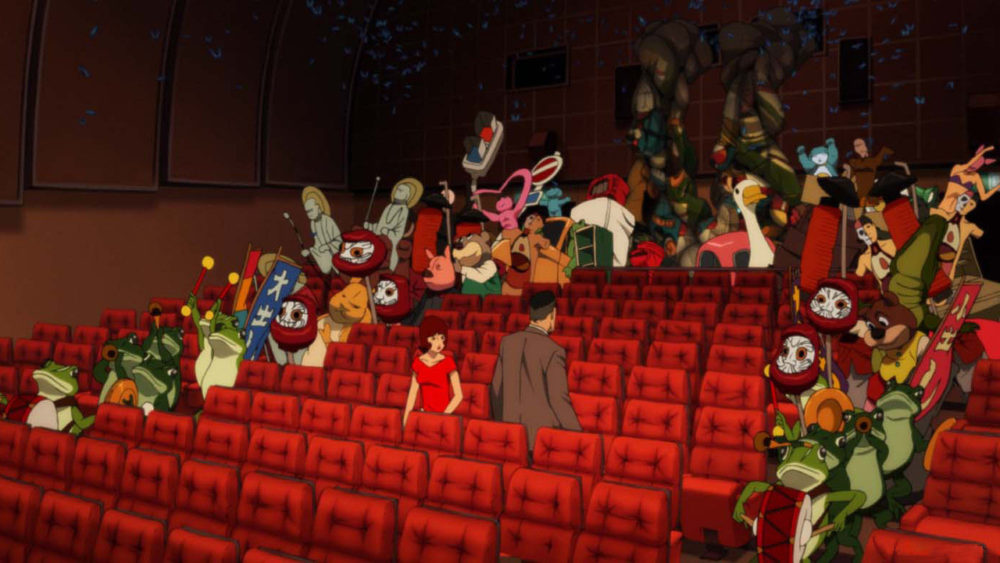
“I don’t really like movies all that much,” Detective Toshimi Konakawa hesitantly says near the start of Paprika. It’s all bullshit, of course, as the film proceeds to showcase just how much the character genuinely adores cinema. His disillusionment with it comes in many forms, but he realizes that his love of cinema comes from creating cinema, long ago. Over the course of the film, Paprika reveals it’s about more than dreams: it’s about the process of filmmaking and how creativity can be stifled and encouraged by those around us.
The opening segment of Paprika shifts through a number of riveting genre-flavored scenes: the grandiose Cecil B. DeMille-style circus, which is proudly introduced with the character of Paprika yelling, “It’s the greatest showtime!”; the Tarzan jungle-adventure film that features Toshimi carrying Paprika while swinging on a vine; the James Bond spy-suspense film that has Toshimi being strangled by a man whose face is hidden in the shadows; the Roman Holiday romance knock-off in which Paprika smashes a guy’s head with a guitar while Toshimi snaps a photo. Lastly is the lengthy dream hallway in which climactic moments happen, a location that doesn’t necessarily reference any film, but would be referenced in another work of art about dreams, Christopher Nolan’s Inception.
Similarities between the 2010 live-action feature and the 2006 animated film are impossible to deny, comparable to the way Darren Aronofsky direct ripped from Perfect Blue for Requiem for a Dream and Black Swan. If not for the fact that Paprika were based on the Yasutaka Tsutsui novel of the same name, one could even discuss Tarsem Singh’s visually stunning The Cell as a precursor, though they trade in vastly different narratives outside of being “films about dreams.”
But, as stated, Paprika is as much about dreams as it is about films, and director Satoshi Kon makes it explicit how much he loves the cinematic medium of animation. While he does little to change what makes the individual aforementioned scenes pop in live-action, he places them within a universe where anything can happen. Sure, a live-action film could quite easily cut between these moments, but an animated film can showcase these moments and immediately drop the characters into a world where reality and dreams are blending. The parade of loud, colorful figures, frogs, toys, and dolls that rampage through the dreamscapes presented in Paprika are a perfect example of this. No special effects could make that, or something like the grand battle between Paprika—or, rather, the psychiatrist behind the alter-ego, Doctor Atsuko Chiba—and Doctor Seijirō Inui in his final form, feel realistic.
Instead, Kon takes glee in maximizing what he does within dreams with his animation. As much as he’s taken glee in messing with perceptions of reality, Paprika offers an even more bountiful universe than usual, one where anything can be real or fake. It’s a whole new world for Kon, though he never forgets his previous work. As this film warns, forgetting the past is foolish and one of the many things that stifles creativity. It’s the reason why a character like Toshimi only realizes his full potential in the face of complication when he admits the truth about himself; he loves film and fondly remembers making his experimental work of art on 8mm, he regrets dropping the project entirely and ditching his friend, and he needs to accept that it was a mistake to do so in order to make progress as a human being.
In more ways than one, this line of thinking makes the viewer wonder if Kon is speaking for himself through both the characters of Toshimi and Atsuko, and even in Doctor Kōsaku Tokita, the childish inventor of the DC Mini, the film’s dream-entry machine. Throughout the feature, all three of these characters look at dreams as a form of expression and catharsis and a way to transport people into something else entirely. Toshimi processes his life through cinematic dreams, Atsuko hopes to use dreams to provide people with the results to their problems or reflection, and Tokita sees the world as one of pure wonder, creating a machine to enter dreams as a result of that. In multiple instances, the boundaries between real and unreal, or one dream and another, are that of the camera lens and the screen films are projected on, used to transport individuals. Approaching one’s dreams and trying to mold them into something that reflects what the dreamer wants to experience is a perfect mirror for a filmmaker attempting to craft a work of art that fits his vision.
What of the villains in Paprika, specifically the chairman, Doctor Seijirō Inui, whose entire purpose is to stifle the creativity that Paprika, Tokita, and their partner Doctor Toratarō Shima bring to the world for his own gain? If we look at the rag-tag team of scientists and detective as the filmmakers, the people attempting to dream as those trying to bring a pure vision to the screen, we can see the chairman as the overbearing studio head that seeks his own interest to the detriment of the art. Alongside him, Doctor Morio Osanai, the colleague of Atsuko Chiba, exists as the overbearing producer, prone to three things: sexual assault on set disguised as unrequited love in his eyes, attempting to steer the production in a manner that would benefit him, and being manipulated by the studio to ensure the results benefit them both. As with some of this other films, Kon also toys with the notion of oppressive masculinity in Paprika through these two characters and how that impacts independent individuals, both male and female.
Of course, not every film production can be read like this; many have positive experiences, though it seems Satoshi Kon is not-so-subtly coding his film as something about the trials that come with filmmaking. Filmmakers are at their freest and most inspired when they aren’t tied down by the shackles of negative influences or monetary limitation. Criticism from outside forces is another aspect that bogs down ambitious filmmakers, often coaxing them into not realizing that their art is worthy when it is and realizing that just as life influences art, art influences life. “It’s truth that came from fiction. Always remember that,” one character says near the end, and with Paprika, Kon seems to be offering a personal truth of his own through fiction.
The last scene of the film shows Toshimi approaching a movie theater to buy a ticket to one of three films showing: Perfect Blue, Millennium Actress, or Tokyo Godfather. It’s a refreshing image, something amusing that works out as a tribute to Satoshi Kon’s body of work, but also establishes the filmmaker as the ultimate fan of movies. It’s an image that reads like Kon nudging the audience and reminding them that in making great films, one must know and love film, even the ones that they themselves have made, flawed as they may be.
—
Directed by Satoshi Kon; written by Satoshi Kon and Seishi Minakami; based on the novel by Yasutaka Tsutsui; starring Megumi Hayashibara, Tōru Furuya, Tōru Emori, Katsunosuke Hori, and Akio Ōtsuka; 90 minutes



 Derek
Derek
 Isabelle
Isabelle